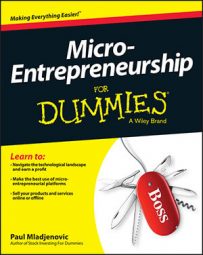Hiring an employee isn’t a light decision, so if you decide to add permanent people for your micro-entrepreneurial business, tread carefully. Outsourcing is a temporary and limited solution for some workload issues, but when your business grows and you need regular, daily assistance, you can consider hiring people.
Before you hire a permanent employee, however, you should consider the significant associated labor costs (even for a part-time employee). A permanent employee is an ongoing expense (the total labor cost), week in and week out, whether your business is generating revenue or not.
In fact, the labor cost will probably be higher than you expect. For example, an employee’s $50,000 salary isn’t the same as labor costs. A general rule is that the cost of an employee will be at least 30 percent higher than the gross pay. In some states (such as California), it may be higher.
Make sure you do the math and see whether hiring an employee will benefit your enterprise and perform functions that either increase sales or decrease expenses (or a combination of both) to a greater extent than the labor cost of having an employee.
When you hire permanent employees, you open some significant doors that you shouldn’t take lightly. You should seriously consider the decision and hold off hiring employees until you absolutely need to.
Identify payroll taxes associated with employees
As an employer, you’re responsible for paying the payroll taxes for each employee you have. Payroll taxes come in several different forms, including the following:
Federal taxes: The single biggest cost, above and beyond the gross pay that the employer pays the employee, is the employer’s share of federal statutory taxes, including FICA (Social Security), Medicare, and FUTA (unemployment) taxes.
FICA and Medicare taxes for the employer mirror those of the employee; 7.65 percent of gross pay (up to the level of $113,700 in 2013).
In other words if you pay $50,000 in gross pay for the employee, then the employer will pay $3,825 ($50,000 times 7.65 percent) on top of that pay (and you, as the employer, are responsible for submitting both your portion and the employee’s portion to the IRS during the tax year).
State and local taxes: Every state and local jurisdiction is a little different. Some have high payroll taxes and some don’t. Check with both the state’s tax department and your tax person. Some state unemployment taxes are paid fully by employers while others are shared by both the employee and the employer.
Recognize other employee-related costs
The associated cost to having an employee goes further than you may expect. In addition to payroll taxes, here is a laundry list of the most common mandatory costs related to having an employee:
Worker’s compensation insurance: This cost differs in every industry and is more prevalent in those industries with a higher degree of risk for occupational injury.
Reports: There are indirect costs of having employees. Many businesses need to file various government reports annually, quarterly, and/or monthly with appropriate government agencies. Filing these reports costs time and effort. Your accountant may also charge you for doing so.
Costs not mandatory but usually covered by the employer include:
Paid vacation: When you have an employee, providing two weeks of paid vacation is standard practice.
Benefits, such as health care insurance: The employer may share these costs with the employee.
Access to retirement plans, such as 401k: To get and keep good employees, it’s important to provide them access to ways to save and invest for their future.
Avoid hiring an employee until it’s necessary and you have the cash flow to pay for the cost.

